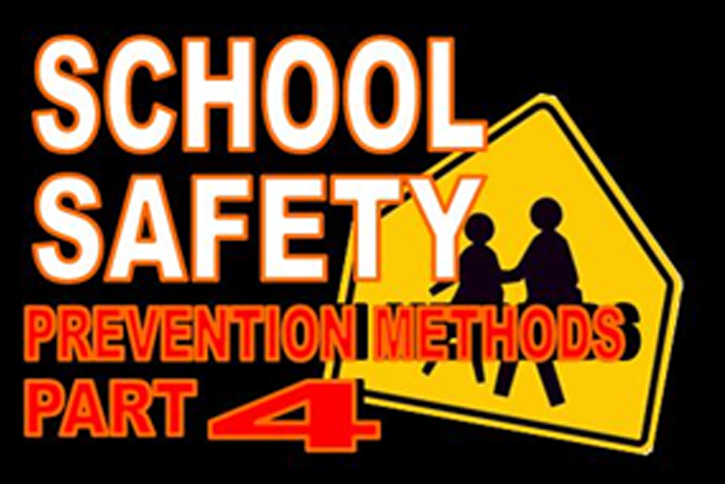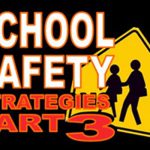ACTIVE SECURITY – POLICIES – TRAINING: WHAT YOUR SCHOOL DID (OR DID NOT) DO ON SUMMER VACATION? AWARE, PREPARED, & ON GUARD
ACTIVE SECURITY
Active self-defense/safety begins by accepting the responsibility for change in our schools. Fundamental assurances for a positive and safe environment must be provided to nurture relationships among individuals; throughout the community; and into society at-large. Awareness is much more than realizing that things can and do happen. Clearly, threats and violent acts occur much too frequently. It is imperative that there is no room for complacency. Likewise, there is no room for half measures. An attitude of “not me” or “not here” or “nothing ever happens where I live” are foundations for disasters. Awareness is not simply making the possibilities known but it is also providing the obvious and visible presence, along with the diligence to deter unacceptable and violent behaviors, and to preempt and make corrections wherever possible.
Discipline is required for a safe and engaging learning environment. Respect is the beginning of corrective action. It should be clear that building character skills, like courtesy, respect, integrity, honor, self-control, and responsibility are just as necessary to develop productive students/citizens and a progressive community as are science, technology, engineering, and mathematics (STEM) knowledge.
The physical brick and mortar facility can provide numerous opportunities for awareness. Visible deterrents include signage; clear line of sight at main entrance; controlled access in coordination with the line of sight. Numbered windows and doors to easily identify areas and “zones” within the building. Active shooter alarms; warning systems; and lock-down devices. Automatic lockdown devices can be operated building-wide in an emergency and can be controlled to a specific room level. These eliminate hiding a device in a certain drawer of the teacher’s desk; the ill-timed misplacement of the device; and the limited knowledge of the availability of the device. All of these possibilities not only exist, they are very visible to everyone who enters the building and they clearly send a message of awareness and preparedness to deal with a violent situation.

There are numerous opportunities for not-so-obvious measures as well. These include unspoken communications, like distress signals in classrooms; student seating placement; visibility from inside and outside the classroom, for example.
Metal detectors, while functional and visible, are expensive, provide limited real-security, and require monitoring at the point of operation. The number of access and egress points in a school are numerous; on average, there are nearly thirty in any given building. The risk of bypassing the metal detectors is significant, and it is quite likely to occur.
Cameras throughout a facility, both inside and outside, however are a must. Monitoring all entrances and exits, along with key areas for maximum security is easily performed by a single individual by this method. Diligence is also a significant key to success. When incorporated with ma metal detector they add value to that otherwise limited approach.
Personal experience has demonstrated that successful security is the result of training, diligence, and reassurance that methods are followed, updated, and always functioning. Too often, when visiting schools, doors are propped open, politely held, and administrative staff is caught off-guard by the presence of a stranger in their environment.
Recent research by a Rutgers University-New Brunswick-led study reports that Common Wi-Fi Can Detect Weapons, Bombs and Chemicals in Bags, .(Rutgers University, 2018 IEEE Conference on Communications and Network Security on Cybersecurity). Wi-Fi, or wireless, signals in most public places can penetrate bags to get the dimensions of dangerous metal objects and identify them, including weapons, aluminum cans, laptops and batteries for bombs. Wi-Fi can also be used to estimate the volume of liquids such as water, acid, alcohol and other chemicals for explosives, according to the researchers.
This system, while not yet robustly developed, promises to be a low-cost method that is akin to airport security. Recent experiments with 15 types of objects and six types of bags demonstrated detection accuracy rates of 99 percent for dangerous objects, 98 percent for metal and 95 percent for liquid. For typical backpacks, the accuracy rate exceeds 95 percent and drops to about 90 percent when objects inside bags are wrapped. Indeed, Wi-Fi has other applications to improve the safety and security. “Hot spots” and “Not spots” are a method to control the use of personal devices and assure both appropriate use and a positive learning environment. Limiting the use of Wi-Fi for personal device use by students to only common spaces (e.g., cafeterias, library, auditorium) assures the learning environment and frames responsibility. It improves the classroom activity and focusses students on the purpose of education by eliminating the use of personal devices in those locations.
The presence of law enforcement, school resource officers, and police are definitely a plus in deterring school violence but, it does not always mean that the use of firearms are the most salient and necessary method of assuring security. There is much debate about the presence of firearms in schools and it is worthy of concern. For the purpose of this article, suffice to say that it does not matter how skilled a person is with a firearm when it is discharged; since the bullet does not know when r where to stop, accidents can and will happen by the very nature of the targets and the physical make-up of the brick and mortar facility.
However, random stops by police while doing daily rounds in the neighborhood can add visibility, assure discipline, and provide control and deterrents. Moreover, K-9 officers within the school can provide that same presence and add the power of the dog’s nose to detect and help to eliminate drugs and contraband on campus. K-9 value can be added not only on special visits, but on a routine and even daily basis for greater benefit and at lesser risk than firearms.
POLICIES
Discipline can come in other forms too. Student uniforms, or, at minimum, dress codes, can provide a visible sense of equality to forego bully behaviors that are driven by styles (good or bad), and financial differences. They afford a commonality among the student body.
Student, faculty, and administration photo-identification cards can be a requirement to assure recognition but also to develop responsibility. Access to the facility for visitors should also require a temporary photo-i.d. card. Along with the card, there should be policies set to enforce the rules, e.g., if you lose your i.d., it must be replaced; show up without it and to gain access to the school, you must report to the office for a temporary i.d. tag. Replacement of lost i.d. cards would be required for a fee.

Teachers and aides are routinely assigned responsibilities to monitor lunchrooms, playgrounds, and bus transportation for students. Hallway monitoring before, between, and after classes is also necessary. In many schools, the opportunity to show the presence of adult authority has been overlooked. Yet, it serves as a deterrent and should be part of standard operating procedures for the administration and management of every school. When there are rules and the rules are enforced, there is better behavior.
We cannot ignore disciplinary actions and challenges; administrative reporting red-tape; individuals under the influence of pharmaceuticals and drugs; social separation and isolation; bullying empowerment and clique behaviors. Rules and discipline are a MUST. It is a part of the educational system that has most recently been severely limited.
Students will learn and behave according to examples that are clearly presented and demonstrated (integrity, character, civility, morality, legal purposefulness). It is a given that students will take advantage of the system if they are able to do so.
Take, for instance the privilege of driving to school instead of riding the bus. The student who acquires the parking permit agrees to random drug testing and must pay a small fee (hardly denting the expense to provide a seat on the bus for them) for the parking spot. The student who drives and parks off campus or the person who rides with an officially permitted driver does not undergo the same random testing nor any fees. They have more unsupervised, and significantly less traceable access to the school. This is a weak link in school security. Administrative planning, organization, rules, enforced discipline, and positive examples with positive reinforcement are absolutely necessary to provide a safe, learning environment and all loose ends need to be upgraded to secure practices.
The primary reason that children are required by law to attend school is academic development. Social experience is important and a close second to hitting the books. Without a positive learning environment, neither can be successful and certainly will not thrive.
The “walk up” philosophy is a proactive approach to improving the school and learning environment. Rather than protest and “walk-out”, the community is enriched. It is an approach that builds a strong and positive community. At its core, it develops an environment that nurtures engagement and positive social behavior. It fosters personal engagement, respect, discipline, and trust among students, teachers, and administrators. Positive changes are encouraged and accomplished by demonstrating leadership and strength of character simply by treating others as one would like to be treated.

TRAINING
Security is highly valued. To achieve it, continuous training is necessary for the entire school population. It includes and must incorporate personal responsibilities, policies, behaviors, as well as realistic safety training for bystanders, along with actively engaged individuals.
Obviously, there is much to do and much more that can be done. This article has presented numerous options but not all of the solutions. There is much more to cover and the message is already quite long. It is imperative to understand that security is an ongoing process. As the risks and threats will certainly evolve, according to opportunities presented by weaknesses, school security must continuously be on-guard, evolve, prepare, and continuously train.
Addressing possibilities on buses, in stadiums, during extra-curricular activities, reactions to routine behaviors in response to threats all need deep thought and measures for improvement. In addition, training must be real, develop a belief that the reaction and defense is realistic and can be performed with success. That buy-in is necessary for maximum security, defense, and survival in a violent situation.
For example, staff and students in the Blue Mountain School District in Central Pennsylvania took their Alert, Lockdown, Inform, Counter, and Evacuate (A.L.I.C.E.) Training and realized that in a “live” active shooter situation, it was not enough. Throwing the tennis balls and practice items that were provided at an attacker during the A.L.I.C.E. Training proved to be unrealistic. It did not empower the trainees with the skills and beliefs they needed. As a result, the rural district has armed every classroom with a five-gallon bucket of river rocks as part of the strategy to protect them against violence. (“Pennsylvania School District: Intruders “will be stoned” by Students Armed with Rocks,” Joel Shannon, York, PA Daily Record, March 23, 2018).
The owners at Makowski’s Martial Arts and Fitness are actively engaged in providing specialized training and continually advancing their own. They are highly qualified, experienced, and certified instructors for law enforcement; public safety; and schools. For detailed information, regarding our programs and training, check out our expanding list of self defense credentials on our Instructors Page



